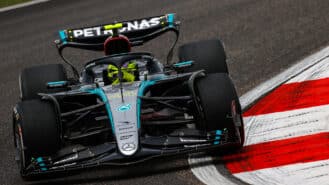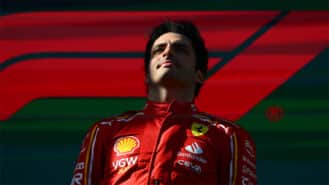
Hamilton moans earn him F1 highlights reel – Up/Down in China
The king of positive vibes has seen his crown slipping recently – a grey day in China only deepened the Silver Arrows' Slough of Despond
For most of the British Touring Car Championship’s weekend at Donington it looked like one of those meetings where the Triple Eight MGs of Jason Plato and Sam Tordoff had it all in hand. By the end of Sunday, however, Team Dynamics and Honda had two world firsts in the history books with their Civic Tourer.
Gordon Shedden gave the car its first front row start, splitting the MGs, before storming to a race three win. Catching leader Colin Turkington at a second per lap in the closing stages, Shedden claimed victory after a titanic scrap and last-corner tussle where both cars shot into the gravel trap. Shedden emerged first to cross the line.
With all the Honda’s success over the first two rounds the consternation from some viewers when it was announced seems a distant memory. So how did the project come about in the first place? After all, it’s been 20 years since the BTCC last featured an estate, Volvo’s TWR-run 850.
“We’d heard that the Civic Tourer was coming through public channels,” says Team Dynamics manager Peter Crolla, “and obviously we’ve got good connections at the factory so we got some inside information from those sources. But it was originally Matt [Neal] who came up with the idea of building a race car out of it.

“At first we laughed it off because the typical perception of an estate is that it’s very big and boxy and it wouldn’t lend itself to being a race car particularly well. Then our marketing company put together a mock-up of what it could look like with the existing livery and we thought it looked good.
“That got the cogs whirring and shortly after that we learned that it was going to be based on the same Civic floorpan and everything was transferrable from the hatchback. It’s predominately an aesthetic thing and it ties in very well with the Honda marketing strategy because the Tourer was its big launch of the year. The whole idea went from strength to strength. A lot of what we learned with the previous car is useful. There’s a slight difference in weight distribution and aero but nothing that’s going to keep us up at night.”
Surprisingly the weight distribution is more limited than with the smaller hatchback, but it doesn’t seem to have been a problem at circuits as varied as Donington and the Brands Hatch Indy layout.

“The car’s now more suited to the longer, faster circuits so Donington and Thruxton are good places for us. We weren’t expecting to go as well as we did at Brands so we were a little surprised by its performance. The car’s a little different to what we were expecting and it requires a little more thinking from Matt and Gordon and a lot more on the engineering side. Nothing we can’t cope with though.”
One aspect of the car that has no bearing on its performance, but will be almost as important to Honda’s marketing department, is public perception. Even in the midst of the techno-colour BTCC pack the car stands out, but whether or not that’s a good thing remains to be seen.
“It seems to be a bit of a Marmite concept but overall the fan reaction’s been really positive,” says Crolla. “It harks back to the Volvo project which was 20 years ago now but, to be fair, that wasn’t particularly successful. So to come out fighting at Brands and score six top six finishes and be second and fourth in the championship after one race weekend was really good. We were certainly happy, as was Honda, and the fan response has been great. You’re always going to get doubters and critics but you get that with whatever you’re doing.

“How long we run it for is yet to be decided and returning to the hatchback is still a possibility. We’re looking at options for next year, one of which may coincide with the Type-R coming out so it’s feasible. We’ve just got to see what takes shape over the next couple of months.”
If the first six races are anything to go by Team Dynamics will be in an enviable position at season’s end. Which one of its championship-calibre cars should it race in 2015?

The king of positive vibes has seen his crown slipping recently – a grey day in China only deepened the Silver Arrows' Slough of Despond

In the face of soul-destroying boredom, only one driver can bring the entertainment needed to rescue a sport which resembles a broken AI tribute to itself

Waking up at 4am on a Sunday is rarely worth it, especially when Max Verstappen looks poised to take another lights out to chequered flag victory — as he did…

Should there be a new prize for a team finishing sixth in the championship – just like the Jim Clark Trophy in the good old turbo times?